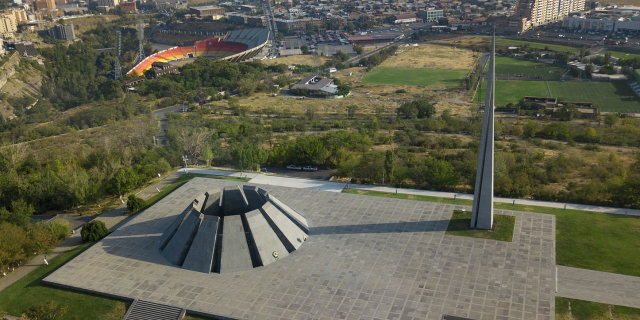Havuts Tar (Armenian: Հավուց Թառ Վանք; also Havuts Tar Vank; translates to the "All Savior Monastery") is an 11th to 13th century walled monastery, situated upon a promontory along the Azat River Valley across from the villages of Goght and Garni in the Kotayk Province of Armenia. It is easily reached via the Khosrov State Reserve (which it is situated within), located across the Garni Gorge. The Havuts Tar Trail leads directly from the east side (left) of the reserve entrance to the monastic complex. An alternate route/shortcut to the monastery can be found at the end of the main road along the Azat River and just past the fish hatchery ponds.
It takes approximately thirty minutes to reach the ruins of the monastery via the Havuts Tar Trail. A couple of khachkars can be found midway along the trail as it forks left upon a very low mound. Also, a short distance from the monastery (clearly visible oh a hill in the background) in a small fie...Read more
Havuts Tar (Armenian: Հավուց Թառ Վանք; also Havuts Tar Vank; translates to the "All Savior Monastery") is an 11th to 13th century walled monastery, situated upon a promontory along the Azat River Valley across from the villages of Goght and Garni in the Kotayk Province of Armenia. It is easily reached via the Khosrov State Reserve (which it is situated within), located across the Garni Gorge. The Havuts Tar Trail leads directly from the east side (left) of the reserve entrance to the monastic complex. An alternate route/shortcut to the monastery can be found at the end of the main road along the Azat River and just past the fish hatchery ponds.
It takes approximately thirty minutes to reach the ruins of the monastery via the Havuts Tar Trail. A couple of khachkars can be found midway along the trail as it forks left upon a very low mound. Also, a short distance from the monastery (clearly visible oh a hill in the background) in a small field to the left, is a large khachkar and a small ruined monument. Following the trail a little further leads to the fortified walls and ruins of the monastic complex. Just before entering the monastery, a small path leads up a hill to the east and through a semi-wooded area. At the end of the path are the ruins of a small chapel with two large khachkars to the left, and a third to the right.
The majority of the Havuts Tar monastic complex was constructed between the 12th and 14th centuries. After having been badly damaged by a large earthquake in 1679, the monastery was effectively abandoned in the years that followed. Portions of the complex were rebuilt in the early 18th century by the Catholicos Astvatsatur Hamadantsi, and some restoration efforts took place in the early 20th century.[1]
The monastery is known to have had a brief visit during October 1734 by Abraham Kretatsi during the time while he was serving the Catholicos Abraham II. He brought a monk as a guide and spent two days there while on his pilgrimage to a number of churches and monasteries across Armenia.[2] His visit to Havuts Tar is mentioned the following brief passage:
In the morning, taking one of the monks as my guide, I went to Havuts Tar, that is, the All Savior Monastery, where I spent two days.[2]























![[node:title]](/sites/default/files/styles/640x320/public/pla/images/2021-03/Monasterio_Khor_Virap%2C_Armenia%2C_2016-10-01%2C_DD_25.jpeg?h=7c882872&itok=TSlbC6VX)





Add new comment